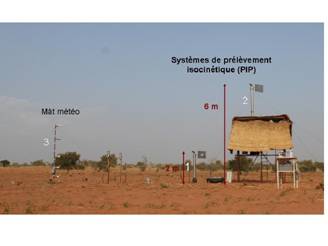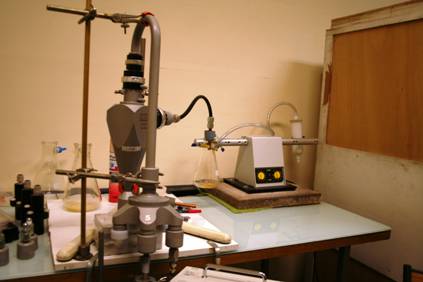Emission model in arid zones
The emission model developed at LISA describes the three stages of the emission process of desert aerosols: the threshold of erosion, saltation (horizontal movement of soil grain) and the sandblasting (production of fine aerosol by disaggregation during the impact on the surface of the saltating soil grains) [Marticorena and Bergametti, 1995; Marticorena et al., 1997; Alfaro and Gomes, 2001]. These works on the understanding of the processes of emissions and their modeling are today a reference on an international level for the simulation of emissions of dust from arid areas of the planet. However, the development, improvement and validation of this model remain a constant concern.
At present, the objectives are :
(i) To validate the parameterization of the aerosol size distribution of particles smaller than 20 µm in diameter on a long distance transport. This work requires having measurements of size-resolved emission fluxes. Measurements of this type were carried out in the Sahel (coll. BIOEMCO, IRD) and in Chile (franco-chilian program EOLOS 2006; 2008) to be confronted with simulations resulting from the model.
 |
Figure 1: Device of measurements of emission fluxes of aerosol deployed on the site of Banizoumbou (Niger): size distributions and concentrations are measured on two levels (2 to 6 m) to estimate vertical fluxes by the method of gradients (see Sow et al., 2010), dynamic conditions (friction speed) are estimated from measurements of vertical profiles of wind speed and temperature on the weather mast.
(ii) To model their mineralogical composition. Indeed, at the time of the emission, a size fractionation is produced between the soil and the aerosol. It is accompanied by a mineralogical fractionation which determines the composition of the emitted aerosols, and therefore is relevant to the estimation of their optical and solubility properties. The mineralogical fractionation is studied in the laboratory through the development of a dust generator using soils collected in different arid and semi-arid areas (program LEFE/CHAT /CNRS 2008-2009).
 |
Figure 2: System of generation of desert aerosols in the laboratory: the soil collected in arid or semi-arid regions are subject to mechanical agitation reproducing the phenomenon of "sand-blasting", i.e. disaggregation by shock of the aggregates constituent of natural soils; a pumping system to collect the aerosol produced to determine its chemical and mineralogical composition by size class and compare it with that of the parent soil.

